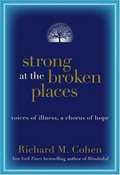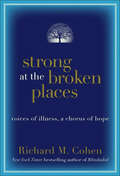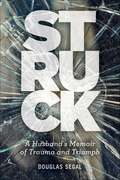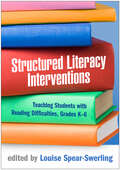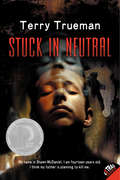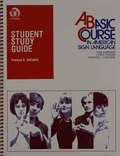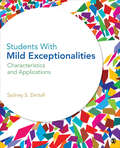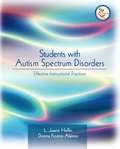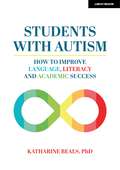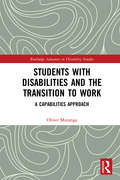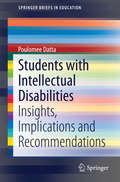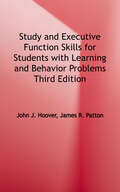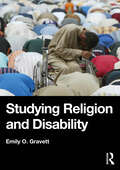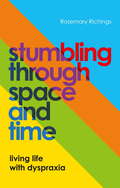- Table View
- List View
Stroke and the Family: A New Guide (The Harvard University Press Family Health Guides)
by Joel SteinA young woman suffers a stroke; she rebuilds her career and personal life, but not before her marriage falls apart. An eighty-year-old man dies unexpectedly of stroke, leaving his grown sons to wonder whether they are genetically predisposed to stroke. A recently retired woman confronts her future with a husband suddenly disabled by stroke. How can she help her husband? Will he ever recover? How will she cope with her own emotional stress? In Stroke and the Family: A New Guide, Joel Stein shows the many faces of stroke and the people it strikes. To the family just beginning to cope with the aftermath of a stroke, the diagnostic tests, drug regimens, rehabilitation strategies, and varied prognoses can be completely bewildering. Because stroke can affect memory, speech, and movement, the impact on everyday routines and close relationships can be especially intense. Stein has produced a book that allows general readers and nonphysicians working with stroke survivors to make sense of the confusing variety of diagnoses and treatment options, and goes on to explore challenges the recovering stroke patient and the recovering family will face during a long recuperation with an uncertain outcome. Stroke and the Family offers up-to-date information and places the current research findings in context.
Strong at the Broken Places: Voices of Illness, a Chorus of Hope
by Richard M. CohenThe stories of 5 chronically ill people, all different in gender, age, race, and economic status, but all determined to live life on their own terms.
Strong at the Broken Places: Voices of Illness, a Chorus of Hope
by Richard M. CohenThe author of Blindsided “gives a voice to the voiceless—the chronically disabled who, in our health-conscious society, are defined by their disease” (Providence [RI] Journal).New York Times–bestselling author Richard M. Cohen spent three years chronicling the lives of five diverse “citizens of sickness”: Denise, who suffers from ALS; Buzz, whose Christian faith helps him deal with his non-Hodgkin’s lymphoma; Sarah, a determined young woman with Crohn’s disease; Ben, a college student with muscular dystrophy; and Larry, whose bipolar disorder is hidden within. Differing in age and gender, race and economic status, all five are determined to live life on their own terms. In Strong at the Broken Places, Cohen shares these inspirational and revealing stories, which offer lessons for us all—on self-determination, on courage in the face of adversity and public ignorance, on keeping hope alive.We are all strong at the broken places—stronger than we think.“The strength of these profiles derives from Cohen’s focus on chronic illnesses that, as he notes, are not ‘sexy’ and generally ‘do not resolve themselves’ . . . These are stories dense with quotidian details.” —The Washington Post“Extraordinary.” —Larry King“Career journalist Cohen doesn’t flinch from probing for truth about relationships, money, fear, and death . . . One only hopes that, with their group presentation to a class of Harvard medical students, these five taught young medicos as much as they could teach Cohen and, through him, us.” —Booklist
Stronger
by Bret Witter Jeff BaumanWhen Jeff Bauman woke up on Tuesday, April 16th, 2013 in the Boston Medical Center, groggy from a series of lifesaving surgeries and missing his legs, the first thing he did was try to speak. When he realized he couldn't, he asked for a pad and paper and wrote down seven words: "Saw the guy. Looked right at me," setting off one of the biggest manhunts in the country's history. Just thirty hours before, Jeff had been at the finish line of the 2013 Boston Marathon cheering on his girlfriend, Erin, when the first bomb went off at his feet. As he was rushed to the hospital, he realized he was severely injured and that he might die, but he didn't know that a photograph of him in a wheelchair was circulating throughout the world, making him the human face of the Boston Marathon bombing victims, or that what he'd seen would give the Boston police their most important breakthrough. Up until the marathon, Jeff had been a normal 27-year-old guy, looking forward to moving in with Erin and starting the next phase of their lives together. But when his life was turned upside down in ways he could never have fathomed, Jeff did not give up. Instead he faced his new circumstances with grace, humor, and a sense of purpose: he was determined, no matter what, to walk again. In STRONGER, Jeff describes the chaos and terror of the bombing itself and the ongoing FBI investigation in which he was a key witness. He takes us inside his grueling rehabilitation, and discusses his attempt to reconcile the world's admiration with his own guilt and frustration. And he tells of the courage of his fellow survivors. Brave, compassionate, and emotionally compelling, Jeff Bauman's story is not just his, but ours as well. It proves that the terrorists accomplished nothing with their act of cowardice and shows the entire world what Boston Strong really means.
Struck: A Husband's Memoir Of Trauma And Triumph
by Douglas SegalOne of life's biggest clichés becomes a horrific reality when Douglas Segal's wife and young daughter are hit head-on by a Los Angeles city bus. Miraculously, his daughter was unharmed, but his wife faced a series of life-threatening injuries, including the same one that famously left Christopher Reeve paralyzed. Following the accident, Segal began sending regular email updates to their circle of friends and family--a list that continued to grow as others heard of the event and were moved by the many emotional and spiritual issues it raised. Segal's compelling memoir is an intimate and honest chronicle built around these email updates, and is a profound example of how people show up for one another in times of crisis. Alternatingly harrowing, humorous, heartbreaking, and hopeful, this is an uplifting tribute to love, determination, and how the compassion of community holds the power to heal, serving as an inspiring testament to the resilience of the human spirit when faced with pain and adversity.
Structured Literacy Interventions: Teaching Students with Reading Difficulties, Grades K-6 (The Guilford Series on Intensive Instruction)
by Louise Spear-SwerlingComprehensive and evidence-based, Structured Literacy (SL) approaches place a high value on explicit, systematic, and sequential instruction. This book brings together leading experts to present a wealth of SL interventions for different components of literacy. Chapters describe instructional strategies for supporting phonological awareness, basic and multisyllabic word decoding, spelling, reading fluency, vocabulary, oral and reading comprehension, and written expression, especially for at-risk readers and those with disabilities. Including case studies, sample intervention activities, lesson plans, and end-of-chapter application activities, the book contains reproducible tools that can be downloaded and printed in a convenient 8½&“ x 11&” size. An NCTQ Exemplary Text for Reading Instruction See also Louise Spear-Swerling's authored volume, The Structured Literacy Planner: Designing Interventions for Common Reading Difficulties, Grades 1–9, which provides blueprints for tailoring interventions based on a learner's reading profile.
Stuck in Neutral
by Terry TruemanShawn McDaniel's life is not what it may seem to anyone looking at him. He is glued to his wheelchair, unable to voluntarily move a muscle-he can't even move his eyes. For all Shawn's father knows, his son may be suffering. Shawn may want a release. And as long as he is unable to communicate his true feelings to his father, Shawn's life is in danger. To the world, Shawn's senses seem dead. Within these pages, however, we meet a side of him that no one else has seen-a spirit that is rich beyond imagining, breathing life. This edition features an Extras section, giving readers even more insight into Shawn's life, and includes a Q&A with Terry Trueman, as well as a sneak peek at the sequel to Stuck in Neutral, Life Happens Next. the guts of my bad news. Books for the Teen Age 2001 (NYPL), Books for Youth Editor's Choice 2000 (Booklist), Top 10 Youth First Novels 2000(Booklist), 2001 Best Books for Young Adults (ALA), 2001 Quick Picks for Reluctant Young Readers (ALA), and 2001 Michael L. Printz Honor Book
Stuck on a Loop: But What If...; Mind Reading; Stuck On A Loop; Waht Is It? (Rollercoaster Series)
by Paula NagelThis is a focus on intrusive thoughts and repetitive behaviour, linked to exam anxiety. Everyone knows Gemma always gets thing 'right' and is top of the class. However she feels under pressure to do well in the Year 5 tests and is becoming increasingly worried. She thinks she has to do certain things to continue to do well and get 'top marks', such as avoiding the cracks in the pavement. This habit starts to take over and Gemma wonders why she is doing this. As the story progresses, Gemma is helped to understand how it can be normal for anxiety and stress to affect thoughts. The metaphor of having a bully in her mind, making her do things she doesn't really want to do, is introduced. She decides to stand up to her inner bully before it takes over. The accompanying, 'Let's talk about. when thoughts get stuck,' highlights how stress and pressure can affect us, including some of the 'catastrophising' and 'black and white' thinking errors that can be linked with exam stress and pressure. Paul Nagel has worked as an educational psychologist for 17 years. This has included working as a Lead Professional Educational Psychologist managing a traded service, as well as holding Senior Specialist posts for early years and disability. Over the years Paula has worked in multi agency teams within paediatric services, youth offending teams, Sure Start and an anti bullying service. She is currently Principal Educational Psychologist (North) for the national children's mental health charity, Place2Be. Before qualifying as an Educational Psychologist Paula was a primary school teacher. Gary Bainbridge is an artist, comics creator and secondary school Art, Photography and Media Studies teacher from Durham. He's best known for the North East based kitchen sink superhero comic Sugar Glider and the Newcastle-set crime fiction comic, Nightbus. Gary teaches at an academy in Northumberland.
Student Study Guide to a Basic Course in American Sign Language
by Tom Humphries Carol Padden Terrence J. O'Rourke Frank A. PaulStudent Study Guide to a Basic Course in American Sign Language
Students Who Are Exceptional and Writing Disabilities: Prevention, Practice, Intervention, and Assessment:a Special Issue of exceptionality
by Gary A. Troia and Steve GrahamThis special issue examines four critical aspects of writing instruction for students with disabilities: prevention, classroom practice, instruction, and assessment. The first article addresses writing strategy instruction for young students at risk for long-term writing difficulties. Next special and general education middle school educators' epistemology is explored regarding writing development and instruction, their self-reported teaching practices, and the challenges they faced as they strive to teach middle school students how to effectively use writing as a communicative medium and learning tool. The third, article reviews and critiques state writing standards and describes an instructional plan to help students with disabilities and other struggling writers master composing strategies and processes that may equip them to meet state standards in writing. Finally, a review is presented of the extant research on various methods of writing assessment, including holistic, primary trait, and analytic scoring methods, with particular emphasis on Curriculum-Based Measurement--an assessment technique well suited for children and youth in special education.
Students Who Drive You Crazy
by Jeffrey A. KottlerOutlines strategies teachers can use to succeed with difficult and hard to motivate young people.
Students With Mild Exceptionalities: Characteristics and Applications
by Professor Sydney S. ZentallThis concise and practical guide thoroughly presents the characteristics of children with specific mild exceptionalities in today's diverse classroom. Using an active, problem-solving approach that reflects how today's students learn, Dr. Sydney S. Zentall identifies the characteristics of children with mild exceptionalities that can be gleaned from observations, written descriptions, and personal interactions. Unlike many texts on this topic, which overwhelm students with extraneous information, The text focuses on the characteristics of these students within general education and special class settings. With this knowledge readers will better understand the implications of characteristics for accommodations and be ready to apply this knowledge with empirically based interventions.
Students with Asperger Syndrome: A Guide for College Personnel
by Lorraine E. Wolf Jane Thierfeld Brown G. Ruth Kukiela BorkFor many students with autism spectrum disorders, getting admitted to college is the easy part. Surviving and succeeding can be quite another, as these students transition into a system that is often unprepared to receive them. Accommodating students whose disabilities very likely fall in social and self-regulatory areas is a particular challenge for disability services providers who are not used to reaching out into so many areas of student life. This comprehensive book offers disability services professionals practical strategies for accommodating and supporting students in all phases of college life and beyond.
Students with Autism Spectrum Disorders: Effective Instructional Practices
by L. Juane Heflin Donna Fiorino AlaimoBroadened public awareness of autism and other associated spectrum disorders, combined with continuing research, means that more students than ever before are being identified with these disabilities. This book is an excellent resource for any teacher working with students who have ASD because it discusses how to identify and describe individuals with autism spectrum disorder, develop effective programs, create contexts for instruction, accommodate sensory issues, use applied behavior analytic instructional strategies and program for challenging behavior. Separate chapters are devoted to communication, socialization, academic skill acquisition and non-academic environments. Information on the use of technology is infused throughout the book and makes this an invaluable reference for educators.
Students with Autism: How to improve language, literacy and academic success
by Katharine BealsBeals describes the root causes of the language and learning challenges in autism, their various academic consequences, and a variety of tools and strategies for addressing them. Drawing on what the most current evidence shows about the nature of autism and which therapies are most successful, the book discusses the implications for autism-friendly instruction in academic subjects, noting the ways in which today's classrooms come up short, and suggesting various adjustments that teachers can make.Instead of focusing on social and behavioral issues, general accommodations, and general ways to address learning difficulties, Beals zeros in on academics, on accommodations within specific academic subjects, and on techniques that target autism-specific deficits, situating the issue of educational access within the broader context of disability rights, neurodiversity, and debates about what disability rights and neurodiversity should encompass.Complete acceptance of individuals on the autism spectrum must include complete educational access. This means rethinking assumptions about autistic students, about how we teach expressive language, about how we teach reading comprehension, and about what and how we teach in the many K-12 classrooms attended by autistic students.
Students with Autism: How to improve language, literacy and academic success
by Katharine BealsBeals describes the root causes of the language and learning challenges in autism, their various academic consequences, and a variety of tools and strategies for addressing them. Drawing on what the most current evidence shows about the nature of autism and which therapies are most successful, the book discusses the implications for autism-friendly instruction in academic subjects, noting the ways in which today's classrooms come up short, and suggesting various adjustments that teachers can make.Instead of focusing on social and behavioral issues, general accommodations, and general ways to address learning difficulties, Beals zeros in on academics, on accommodations within specific academic subjects, and on techniques that target autism-specific deficits, situating the issue of educational access within the broader context of disability rights, neurodiversity, and debates about what disability rights and neurodiversity should encompass.Complete acceptance of individuals on the autism spectrum must include complete educational access. This means rethinking assumptions about autistic students, about how we teach expressive language, about how we teach reading comprehension, and about what and how we teach in the many K-12 classrooms attended by autistic students.
Students with Disabilities and the Transition to Work: A Capabilities Approach (Routledge Advances in Disability Studies)
by Oliver MutangaThis book sets out to understand how students with disabilities experience higher education and the transition to the workplace. It foregrounds the voices of students and graduates in order to explore identity, inclusion, participation and success of youth with disabilities in higher education, as well as their transition from university to employment. The author proposes a new understanding of disability, considered in terms of a continuum of abilities, balancing empirical data, theory and policy analysis with specific regard to the interests of youth with disabilities, making a unique contribution to discussions on access, inclusion and success in higher education and employment. These discussions inform social development and educational policy planning and implementation, not only in South Africa, but also in countries with a similar context, particularly in terms of remedial courses of action that bring social justice to people with disabilities. Students with Disabilities and the Transition to Work will be of interest to all scholars and students working in the fields of disability studies, particularly those with a focus on critical disability studies and disability in the global south, as well as those working in higher education, sociology, development studies and social policy.
Students with Intellectual Disabilities
by Poulomee DattaThis book investigates the self-concept of the students with intellectual disabilities who were placed in specialist and mainstream educational settings in South Australia. It gains insights into what students with intellectual disabilities felt about themselves and their achievements across the different dimensions of self-concept. It is divided into two stages of execution. In Stage 1, the Tennessee Self-Concept questionnaire was administered to students with intellectual disabilities. In Stage 2, interviews were conducted with students with intellectual disabilities, their parents and teachers. These data reflected a range of viewpoints from which to examine the research questions. These findings have implications for teachers, special educators, policy makers and a range of professionals in the education and special education sector in enabling greater understanding of the problems experienced by these students and pointing to modifications and improvements in the services for these students.
Students, Colleges, and Disability Law
by Stephen B. ThomasThis text examines the obligations and rights of students with disabilities and the institutions they attend in higher education, including guidelines for university administrators.
Study Skills and Dyslexia in the Secondary School: A Practical Approach
by Marion GriffithsThis book is aimed at those who encounter secondary school students with dyslexia on a daily basis. It takes a practical approach by breaking down the whole process of assessing the issues involved and then suggesting ways for teaching staff and students to implement a suitable program of study skills. It is well structured, clear, useful and written with the needs of busy teachers and students very much in mind. Included are assessment approaches, checklists, photocopiable activities, and suggestions for useful resources. Results from qualitative research are included to provide an additional practical insight into study skills and dyslexia in the secondary school. Theoretical knowledge has been used to underpin and inform practice. Teachers of students with dyslexia who are not specialists should find this a useful guide. It will also be of great use to SENCOs and Teaching Assistants.
Study Skills for Students with SLCN: A Group Programme Supporting Young Students Through Revision and Exams
by Bhaveshi KumarThis highly practical resource has been designed to support professionals working with students who have SLCN (Speech, Language and Communication Needs) following a mainstream educational curriculum. Structured as a flexible 10-session programme, it takes a holistic approach to learning, encouraging students to take an active role in their studies by identifying individual learning strengths and building a "toolbox" of successful strategies for revision. With photocopiable pages and downloadable resources, the advice and skills explored in this programme can be adapted to suit students with a range of abilities and incorporated into a timetable that can be used flexibly, over as many weeks as necessary, with very little planning required. Sessions focus on: Learning about revision and study methods, using a combination of visual, auditory and kinaesthetic techniques Creating a study skills folder and revision timetable Teaching command words (words used in exam questions) and exam preparation Building healthy study habits and managing anxiety Being proud of achievements and developing self esteem Setting goals and becoming independent Created to support a range of students, including those with a known diagnosis of autism, developmental language disorder, dyslexia, dyspraxia and attention deficit hyperactivity disorder, this is an invaluable resource for all professionals looking to support young adults in the build up to exams.
Study and Executive Function Skills for Students with Learning and Behavior Problems: A Practitioner's Guide
by James R. Patton John J. Hoover"This book focuses on study skills and executive function skills for students in grades K-12 who are struggling learners, including those with executive function disorder, dyslexia, and ADHD, to help them with their learning and behavior problems". --Provided by publisher.
Studying Religion and Disability
by Emily O. GravettStudying Religion and Disability introduces students to the many compelling and influential intersections between religion and disability. The early chapters offer introductions to the two fields—defining key terms and definitions, tracing their origins and evolutions, while also demonstrating some of the biases and baggage they bring. The organization of the later chapters is inspired by the formal, phenomenological, or “resemblance” approach to understanding religion, exposing students to different dimensions that all religions seem to have in common, such as practices or places, regardless of their specific content.Featuring examples from a variety of religions, this book considers how these religions have intersected with a variety of disabilities across space and time. This book provokes thought and discussion around important questions, including how different disabilities are perceived, represented, and constructed in different dimensions of religion; how and why people with disabilities engage with religion; potential or documented barriers that religions present to disabled people; and opportunities and insights that result when each is viewed through the lens of the other. It will be essential reading for all students of Religion and Disability.
Stumbling Blocks Before The Blind: Medieval Constructions Of A Disability
by Edward Wheatley<P>Stumbling Blocks Before the Blind presents the first comprehensive exploration of a disability in the Middle Ages, drawing on the literature, history, art history, and religious discourse of England and France. It relates current theories of disability to the cultural and institutional constructions of blindness in the eleventh through fifteenth centuries, examining the surprising differences in the treatment of blind people and the responses to blindness in these two countries. <P>The book shows that pernicious attitudes about blindness were partially offset by innovations and ameliorations---social; literary; and, to an extent, medical---that began to foster a fuller understanding and acceptance of blindness. A number of practices and institutions in France, both positive and negative---blinding as punishment, the foundation of hospices for the blind, and some medical treatment---resulted in not only attitudes that commodified human sight but also inhumane satire against the blind in French literature, both secular and religious. Anglo-Saxon and later medieval England differed markedly in all three of these areas, and the less prominent position of blind people in society resulted in noticeably fewer cruel representations in literature. This book will interest students of literature, history, art history, and religion because it will provide clear contexts for considering any medieval artifact relating to blindness---a literary text, a historical document, a theological treatise, or a work of art. <P>For some readers, the book will serve as an introduction to the field of disability studies, an area of increasing interest both within and outside of the academy. Edward Wheatley is Surtz Professor of Medieval Literature at Loyola University, Chicago.
Stumbling through Space and Time: Living Life with Dyspraxia
by Rosemary Richings"In 1994, I was diagnosed with dyspraxia, and I was unable to do everything that children are expected to do by the time they're in school. For me, this included everything from riding a bike and catching a ball, to reading, writing, and basic math."When talking about her dyspraxia, Rosemary Richings is often met with confusion. Why do so few people understand dyspraxia, or even know what it is?Rosemary shares her experience of growing up dyspraxic, and how it impacts her sense of space, time and co-ordination. Diagnosed with DCD at the age of four, Rosemary shares her insights and experience dealing with challenges, from coping with bullies in school to choosing a dyspraxia-friendly university, pursuing self-employment and travelling abroad.Rosemary shares guidance for others about what helped her develop her skills, including ballet and gymnastics, the Wilbarger Protocol (brushing therapy) and equestrian therapy. Full of practical tips and insights into the strategies that gave Rosemary the confidence to succeed, this is an essential guide for other dyspraxics and those supporting them, which shows you how you too can thrive as a dyspraxic person.

